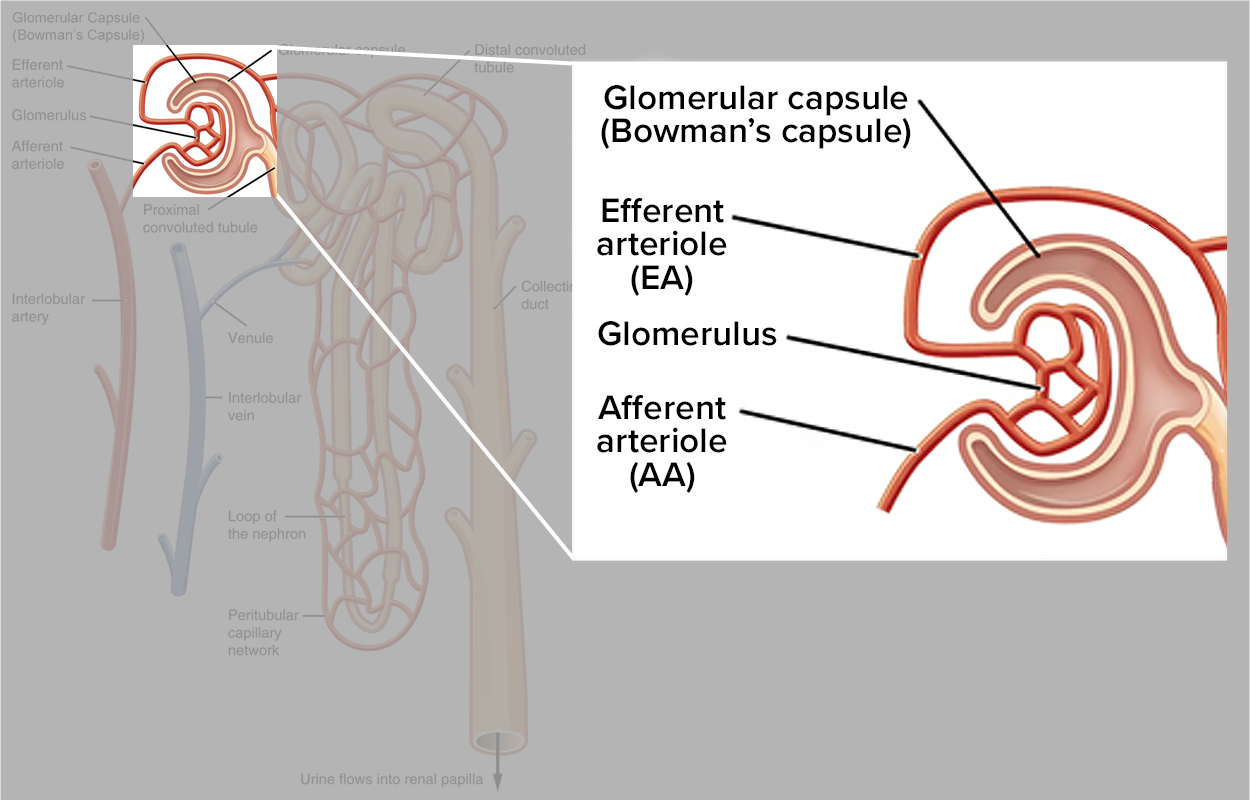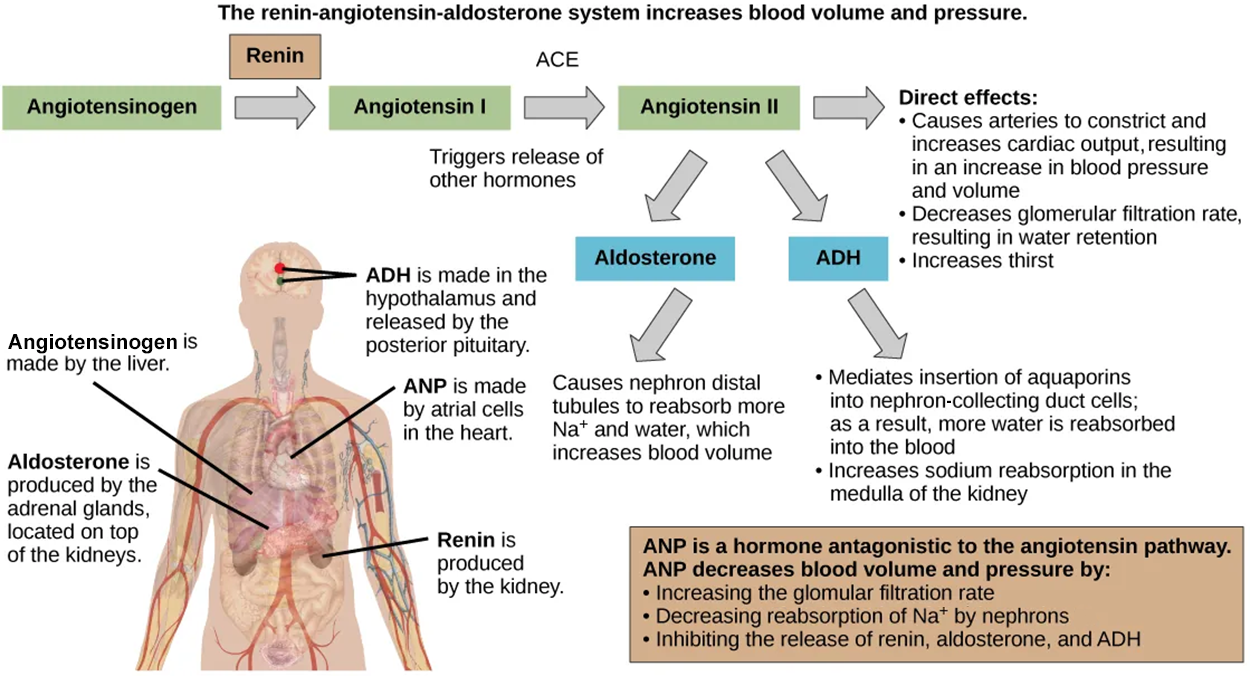Table of Contents |
The kidneys can concentrate urine, and by concentrating urine, they allow for the regulation of both blood volume and blood pressure. Blood volume has a profound effect on blood pressure. The higher blood volume becomes, the higher blood pressure becomes and vice versa. If blood volume drops, then blood pressure will drop. Kidneys essentially concentrate urine or dilute it, depending on the body's needs and what levels blood volume and blood pressure are at.
It is vital that the flow of blood through the kidney be at a suitable rate to allow for filtration. This rate determines how much solute is retained or discarded, how much water is retained or discarded, and ultimately, the osmolarity of blood and the blood pressure of the body. Therefore, mechanisms that regulate this blood flow are essential for the proper functioning of the human body. Throughout this lesson, you will learn more about how fluid balance and blood pressure are regulated by the kidneys.
The body cannot directly measure blood volume, but blood pressure can be measured. Blood pressure often reflects blood volume and is measured by baroreceptors in the aorta and carotid sinuses. When blood pressure increases, baroreceptors send more frequent action potentials to the central nervous system, leading to widespread vasodilation. Included in this vasodilation are the afferent arterioles supplying the glomerulus, resulting in increased glomerular filtration rate (GFR) and water loss by the kidneys. If pressure decreases, fewer action potentials travel to the central nervous system, resulting in more sympathetic stimulation-producing vasoconstriction, which will result in decreased filtration and GFR, and water loss.
Decreased blood pressure is also sensed by the granular cells in the afferent arteriole of the juxtaglomerular apparatus (JGA). In response, the enzyme renin is released. You saw earlier that renin activity leads to an almost immediate rise in blood pressure, as activated angiotensin II produces vasoconstriction. The rise in pressure is sustained by the aldosterone effects initiated by angiotensin II; this includes an increase in Na⁺ retention and water volume. As an aside, late in the menstrual cycle, progesterone has a modest influence on water retention. Due to its structural similarity to aldosterone, progesterone binds to the aldosterone receptor in the collecting duct of the kidney, causing the same, albeit weaker, effect on Na⁺ and water retention.
Cardiomyocytes of the atria also respond to greater stretch (as blood pressure rises) by secreting atrial natriuretic hormone (ANH). ANH opposes the action of aldosterone by inhibiting the recovery of Na⁺ by the DCT and collecting ducts. More Na⁺ is lost, and as water follows, total blood volume and pressure decline. In low-pressure states, ANH does not seem to have much effect.
Antidiuretic hormone (ADH) is also called vasopressin. Early researchers found that in cases of unusually high secretion of ADH, the hormone caused vasoconstriction (vasopressor activity, hence the name). Only later were its antidiuretic properties identified. Synthetic ADH is still used occasionally to stem life-threatening esophagus bleeding in alcoholics.
When blood volume drops 5%–10%, causing a decrease in blood pressure, there is a rapid and significant increase in ADH release from the posterior pituitary. Immediate vasoconstriction to increase blood pressure is the result. ADH also causes activation of aquaporin channels in the collecting ducts to affect the recovery of water to help restore vascular volume.
A diuretic is a compound that increases urine volume. Three familiar drinks contain diuretic compounds: coffee, tea, and alcohol. The caffeine in coffee and tea works by promoting vasodilation in the nephron, which increases GFR. Alcohol increases GFR by inhibiting ADH release from the posterior pituitary, resulting in less water recovery by the collecting duct.
In cases of high blood pressure, diuretics may be prescribed to reduce blood volume and, thereby, reduce blood pressure. The most frequently prescribed anti-hypertensive diuretic is hydrochlorothiazide. It inhibits the Na⁺/Cl– symporter in the DCT and collecting duct. The result is a loss of Na⁺, with water following passively by osmosis.
Osmotic diuretics promote water loss by osmosis. An example is the indigestible sugar mannitol, which is most often administered to reduce brain swelling after head injury. However, it is not the only sugar that can produce a diuretic effect. In cases of poorly controlled diabetes mellitus, glucose levels exceed the capacity of the tubular glucose symporters, resulting in glucose in the urine. The unrecovered glucose becomes a powerful osmotic diuretic. Classically, in the days before glucose could be detected in the blood and urine, clinicians identified diabetes mellitus by the three Ps: polyuria (diuresis), polydipsia (increased thirst), and polyphagia (increased hunger).
Under conditions of stress, sympathetic nervous activity increases, resulting in the direct vasoconstriction of afferent arterioles (the norepinephrine effect) as well as stimulation of the adrenal medulla. The adrenal medulla, in turn, produces a generalized vasoconstriction through the release of epinephrine. This includes vasoconstriction of the afferent arterioles, further reducing the volume of blood flowing through the kidneys. This process redirects blood to other organs with more immediate needs.
If blood pressure falls, the sympathetic nerves will also stimulate the release of renin. Additional renin increases the production of the powerful vasoconstrictor angiotensin II. Angiotensin II will also stimulate aldosterone production to augment blood volume through the retention of more Na⁺ and water. Only a 10 mm Hg pressure differential across the glomerulus is required for normal GFR, so very small changes in afferent arterial pressure significantly increase or decrease GFR.
The anatomy of the glomerulus and Bowman’s capsule (shown below) presents a unique physiological situation. The afferent arteriole flows into the glomerulus, which flows into the efferent arteriole. Both arterioles are resistance vessels whose diameters are influenced by sympathetic nerve activity and the activity of various drugs, which can target either the afferent arteriole or the efferent arteriole independently (see the figure below). As such, the drugs have different effects on pressures in the afferent and affect arterioles, glomerular capsule pressure, glomerular filtration rate (GFR), and renal plasma flow (RPF).

The kidney’s afferent and efferent arterioles are unique in that they are two resistance vessels in series. Therefore, there can be different effects when one is constricted or dilated, and the other is not (this usually happens with certain drugs). For example:
The kidneys are very effective at regulating the rate of blood flow over a wide range of blood pressures. Your blood pressure will decrease when you are relaxed or sleeping. It will increase when exercising. Yet, despite these changes, the filtration rate through the kidney will change very little. This is due to two internal autoregulatory mechanisms that operate without outside influence: the arteriole myogenic mechanism and the tubuloglomerular feedback mechanism.
The myogenic mechanism regulating blood flow within the kidney depends upon a characteristic shared by most smooth muscle cells of the body. When you stretch a smooth muscle cell, it contracts; when you stop, it relaxes, restoring its resting length. This mechanism works in the afferent arteriole that supplies the glomerulus. When blood pressure increases, smooth muscle cells in the wall of the arteriole are stretched and respond by contracting to resist the pressure, resulting in little change in flow. When blood pressure drops, the same smooth muscle cells relax to lower resistance, allowing a continued even flow of blood.
The tubuloglomerular feedback mechanism involves the JGA and a paracrine signaling mechanism utilizing ATP, adenosine, and nitric oxide (NO). Recall that paracrine signaling occurs when a secreted hormone affects nearby cells instead of being transported by the blood or lymph. This mechanism stimulates either contraction or relaxation of afferent arteriolar smooth muscle cells. Recall that the DCT is in intimate contact with the afferent and efferent arterioles of the glomerulus. Specialized macula densa cells in this segment of the tubule respond to changes in the fluid flow rate and Na⁺ concentration.
As GFR increases, there is less time for NaCl to be reabsorbed in the PCT, resulting in higher osmolarity in the filtrate. The increased fluid movement more strongly deflects single nonmotile cilia on macula densa cells. This increased osmolarity of the forming urine, and the greater flow rate within the DCT, activates macula densa cells to respond by releasing ATP and adenosine (a metabolite of ATP).
ATP and adenosine act locally as paracrine factors to stimulate the myogenic juxtaglomerular cells of the afferent arteriole to constrict, slowing blood flow and reducing GFR. Conversely, when GFR decreases, less Na⁺ is in the forming urine, and most will be reabsorbed before reaching the macula densa, which will result in decreased ATP and adenosine, allowing the afferent arteriole to dilate and increase GFR. NO has the opposite effect, relaxing the afferent arteriole at the same time ATP and adenosine are stimulating it to contract. Thus, NO fine-tunes the effects of adenosine and ATP on GFR.
| Paracrine Mechanisms Controlling Glomerular Filtration Rate | |||
|---|---|---|---|
| Change in GFR | NaCl Absorption | Role of ATP and adenosine/Role of NO | Effect on GFR |
| Increased GFR | Tubular NaCl increases | ATP and adenosine increase, causing vasoconstriction | Vasoconstriction slows GFR |
| Decreased GFR | Tubular NaCl decreases | ATP and adenosine decrease, causing vasodilation | Vasodilation increases GFR |
| Increased GFR | Tubular NaCl increases | NO increases, causing vasodilation | Vasodilation increases GFR |
| Decreased GFR | Tubular NaCl decreases | NO decreases, causing vasoconstriction | Vasoconstriction decreases GFR |
The renin–angiotensin–aldosterone system (RAAS), illustrated below, critically regulates blood pressure and blood volume over the long term. This system proceeds through several steps to produce angiotensin II, acting to stabilize blood pressure and volume. Renin (secreted by a part of the juxtaglomerular complex) is produced by the granular cells of the afferent and efferent arterioles. Thus, the kidneys directly control blood pressure and volume.
Renin acts on angiotensinogen, which is made in the liver, and converts it to angiotensin I. Angiotensin-converting enzyme (ACE) converts angiotensin I to angiotensin II. Angiotensin II raises blood pressure by constricting blood vessels. It also triggers the release of the mineralocorticoid aldosterone from the adrenal cortex, which in turn stimulates the renal tubules to reabsorb more sodium. Angiotensin II also triggers the release of ADH from the hypothalamus. You may recall from a previous lesson that ADH promotes water retention in the kidneys by signaling the kidneys to reabsorb water. It acts directly on the nephrons and decreases the glomerular filtration rate.
Specialized cells in the wall of the atria produce and secrete the peptide hormone atrial natriuretic peptide (ANP). ANP signals the kidneys to reduce sodium reabsorption, thereby decreasing the amount of water reabsorbed from the urine filtrate and reducing blood volume. Other actions of ANP include the inhibition of renin secretion, which inhibits the RAAS and promotes vasodilation, and ADH secretion, which also affects kidney function. Therefore, ANP aids in decreasing blood pressure, blood volume, and blood sodium levels.

SOURCE: THIS TUTORIAL HAS BEEN ADAPTED FROM (1) OPENSTAX “ANATOMY AND PHYSIOLOGY 2E”. ACCESS FOR FREE AT OPENSTAX.ORG/BOOKS/ANATOMY-AND-PHYSIOLOGY-2E/PAGES/1-INTRODUCTION. (2) OPENSTAX “BIOLOGY FOR AP COURSES”. ACCESS FOR FREE AT OPENSTAX.ORG/BOOKS/BIOLOGY-AP-COURSES/PAGES/1-INTRODUCTION. LICENSING (1 & 2): CREATIVE COMMONS ATTRIBUTION 4.0 INTERNATIONAL.